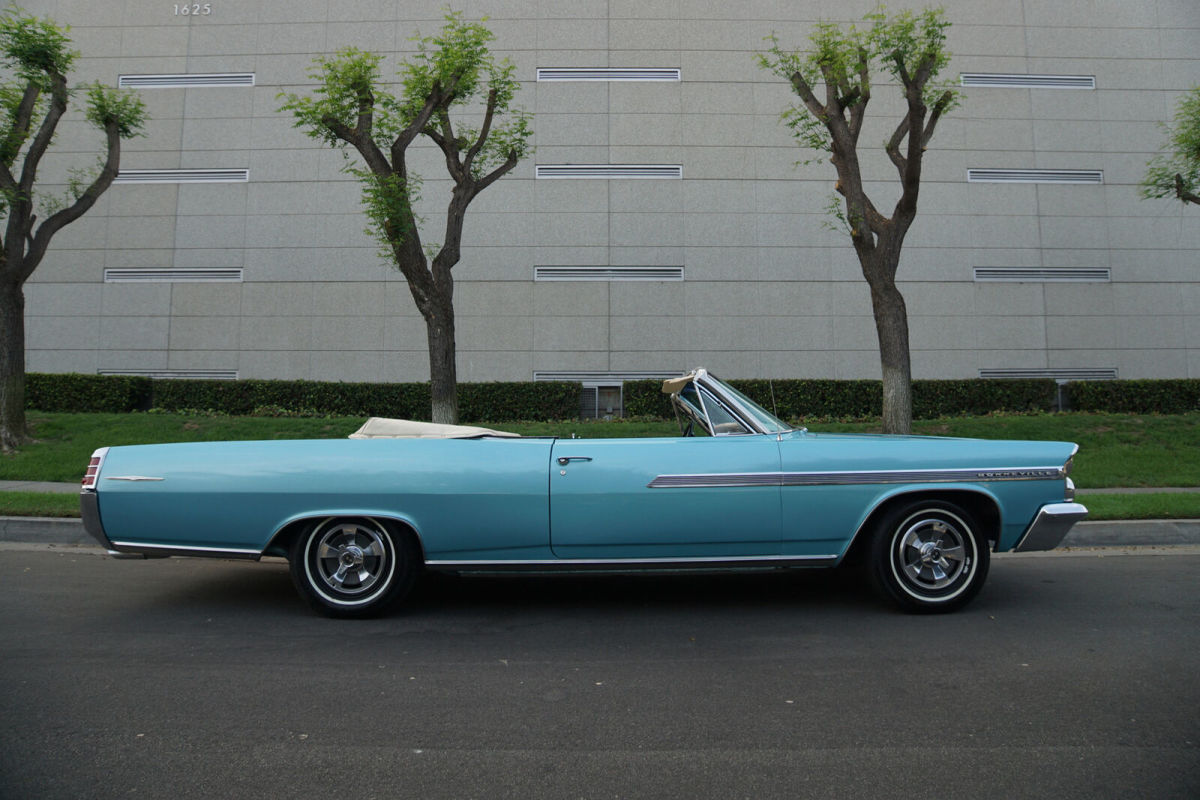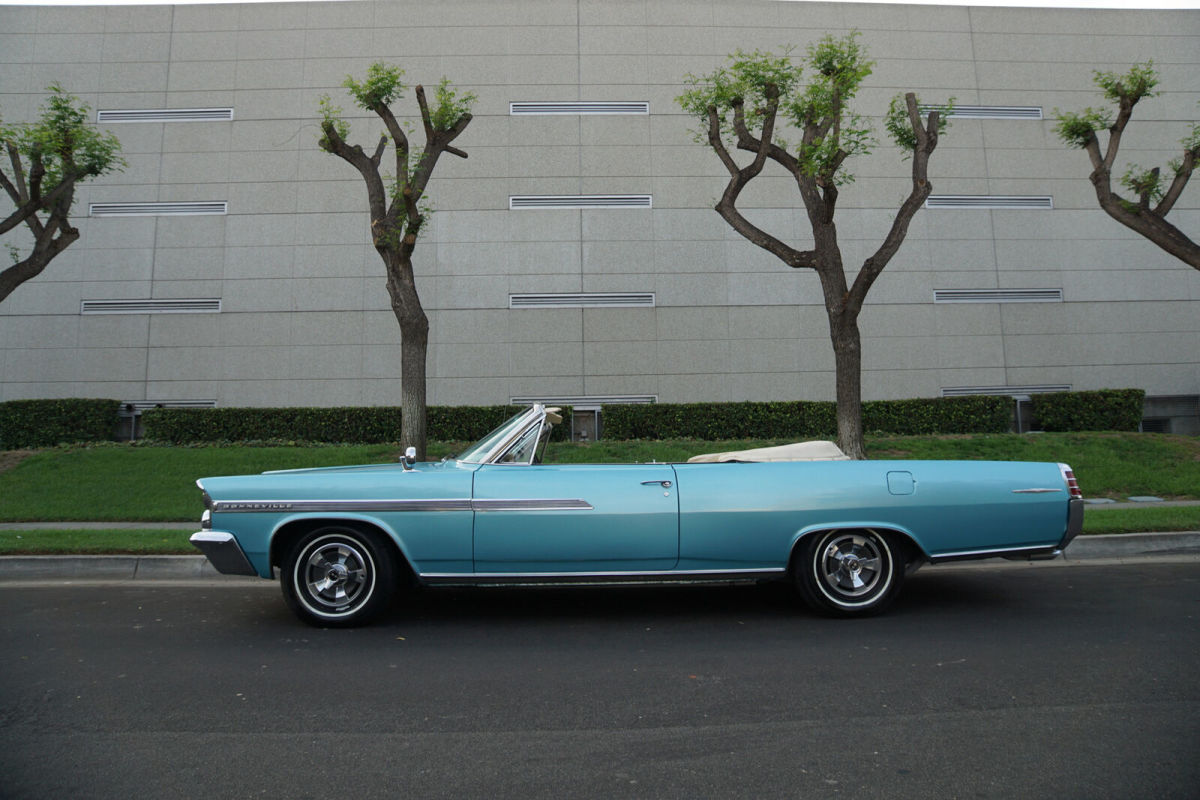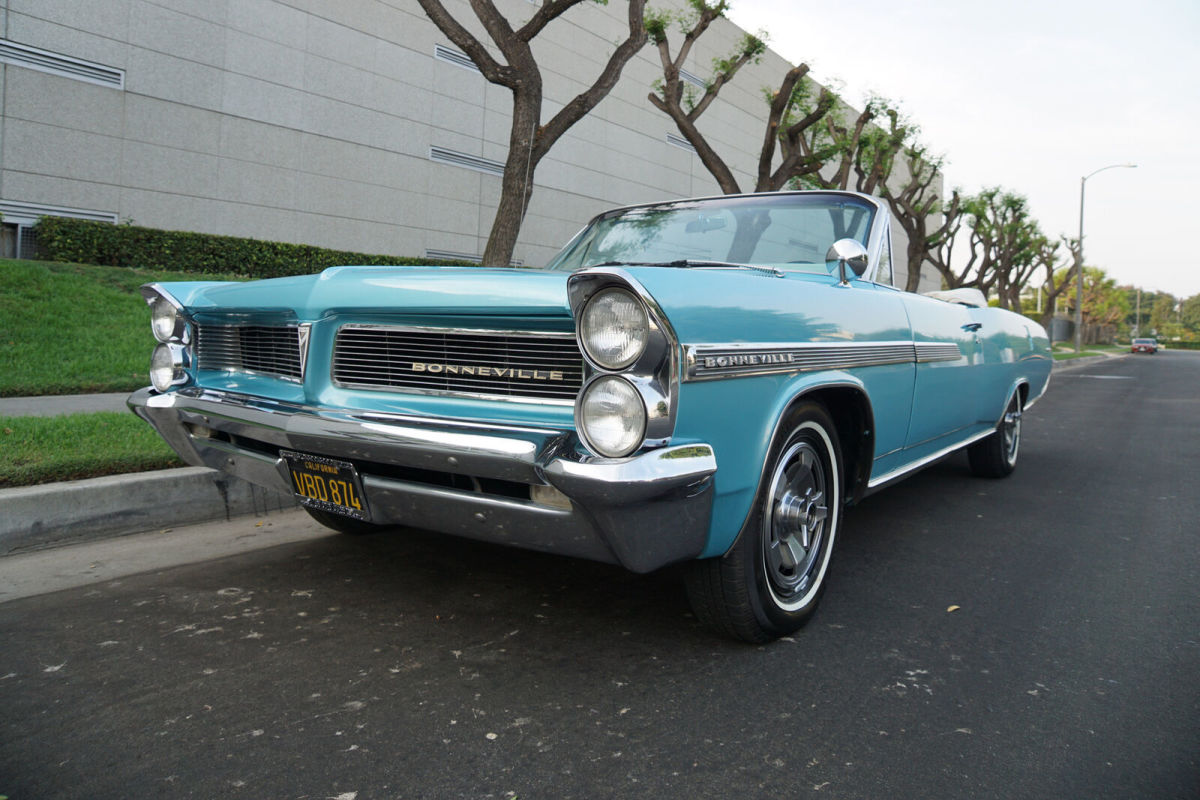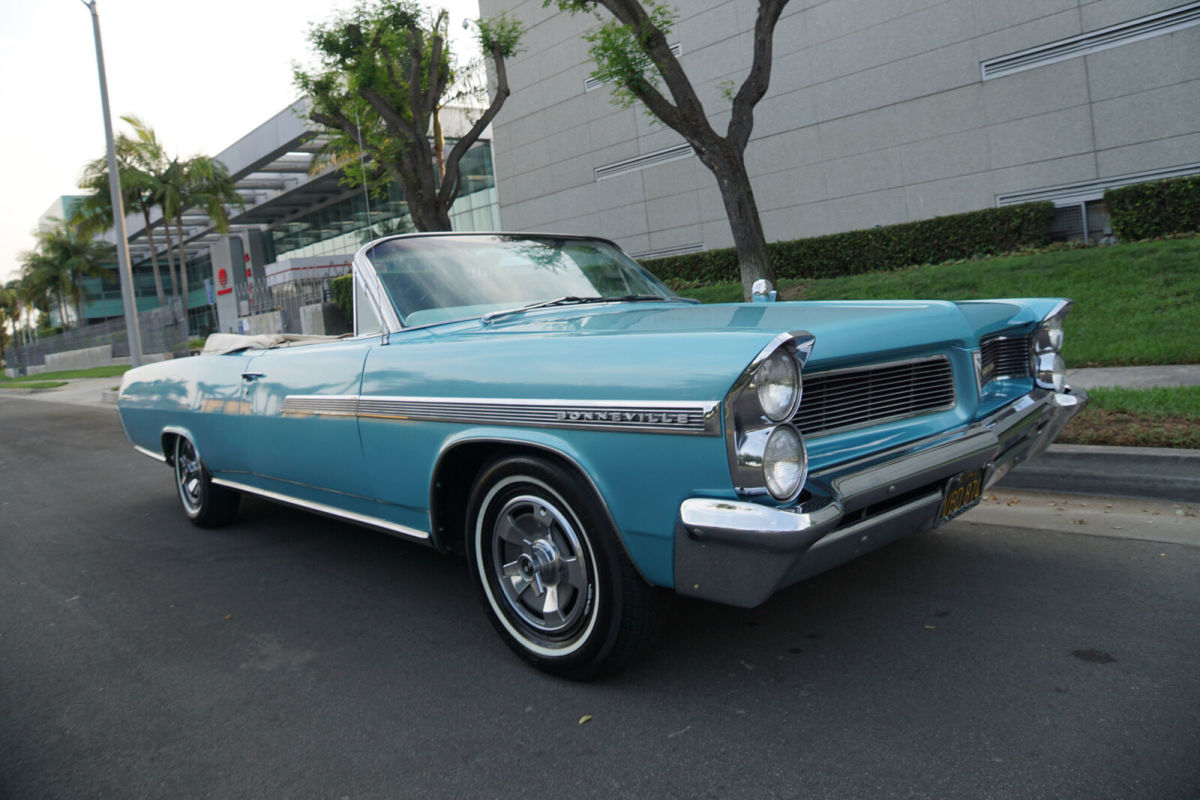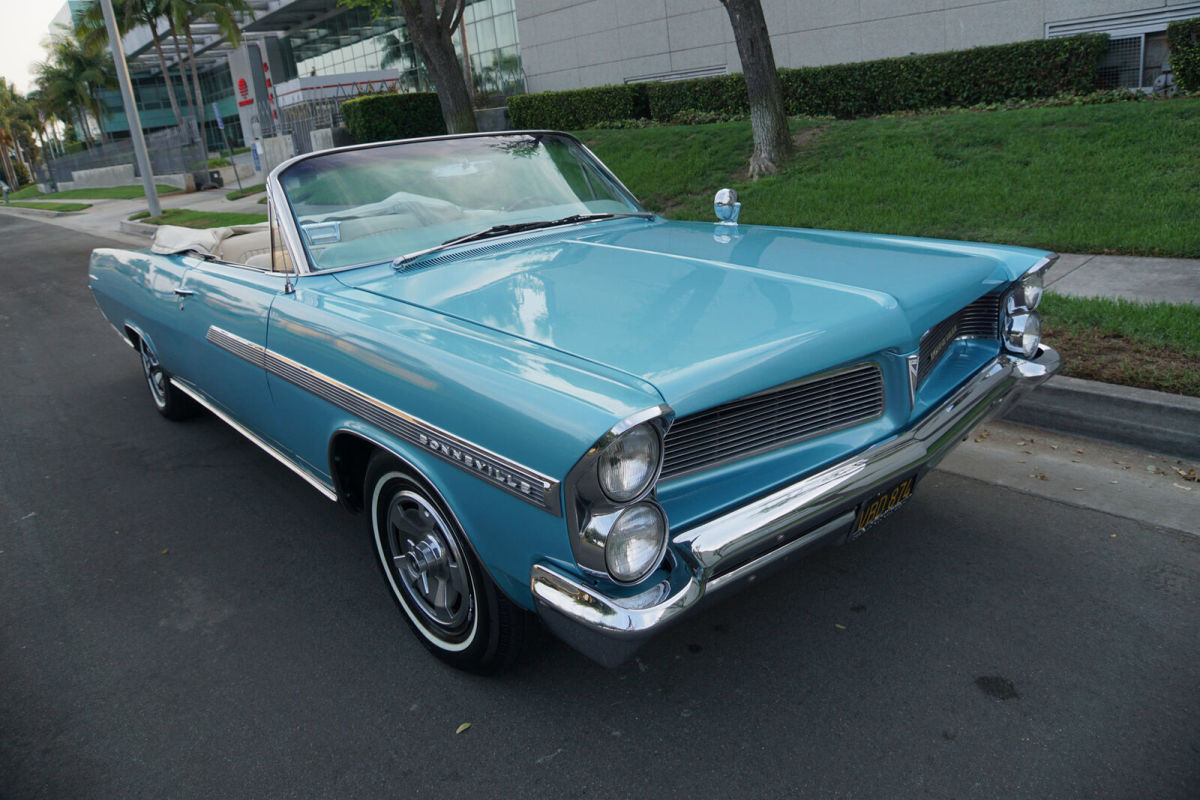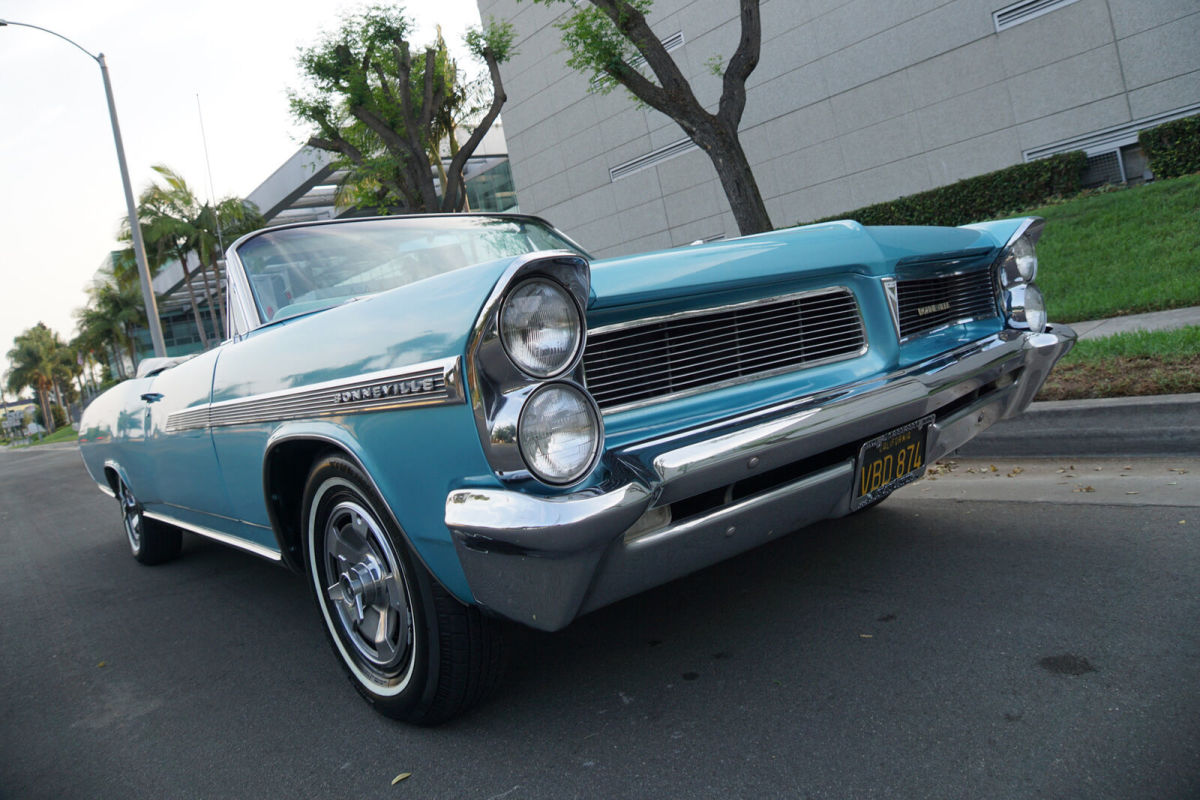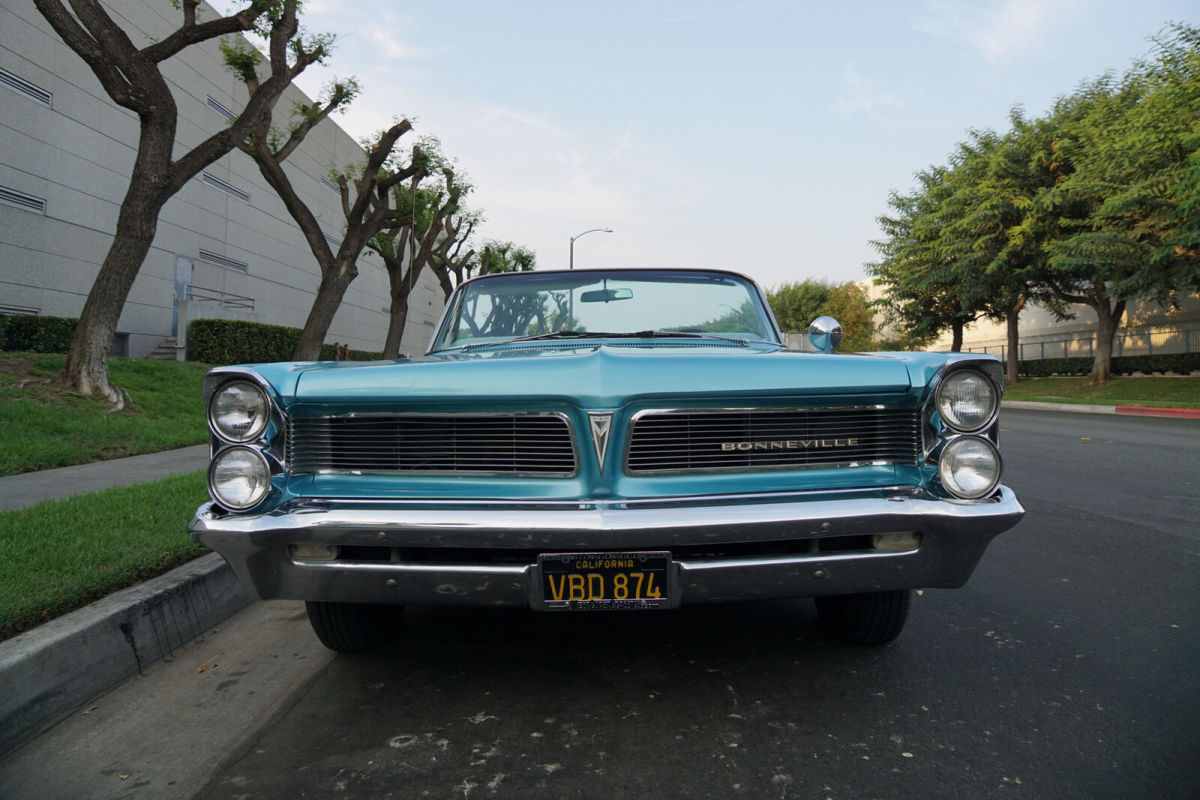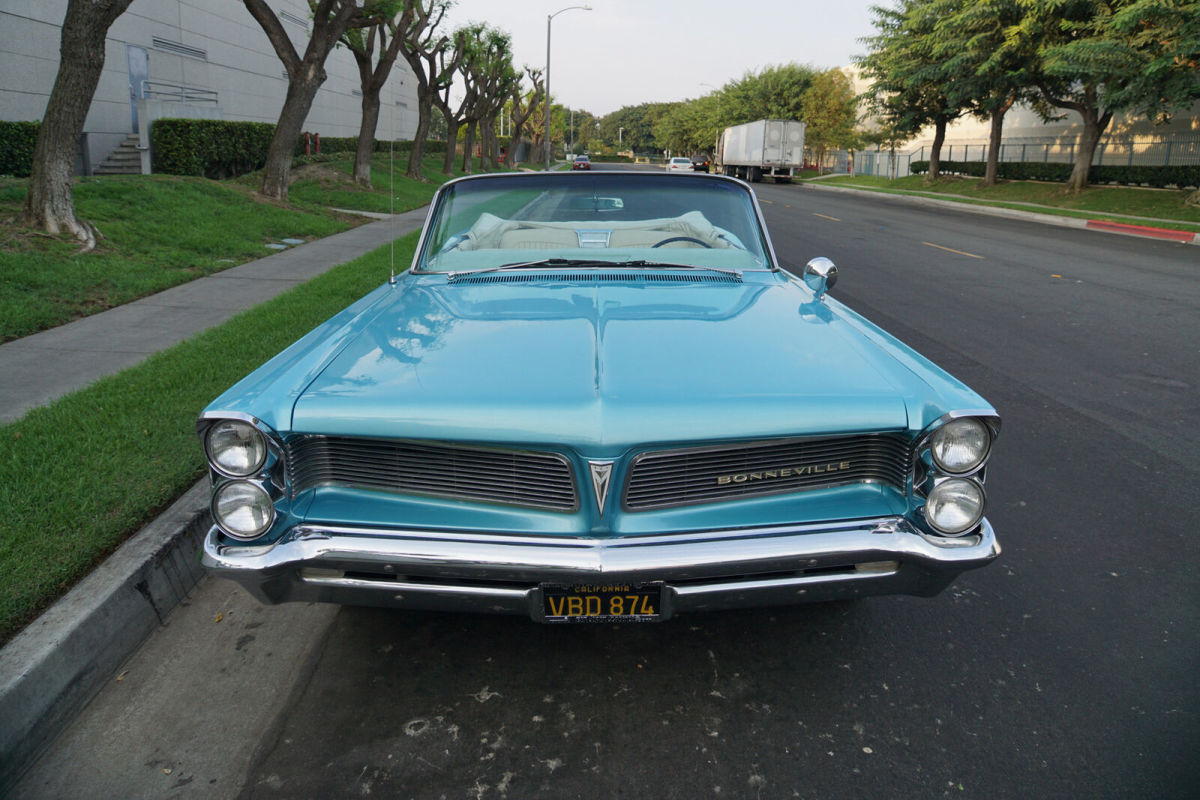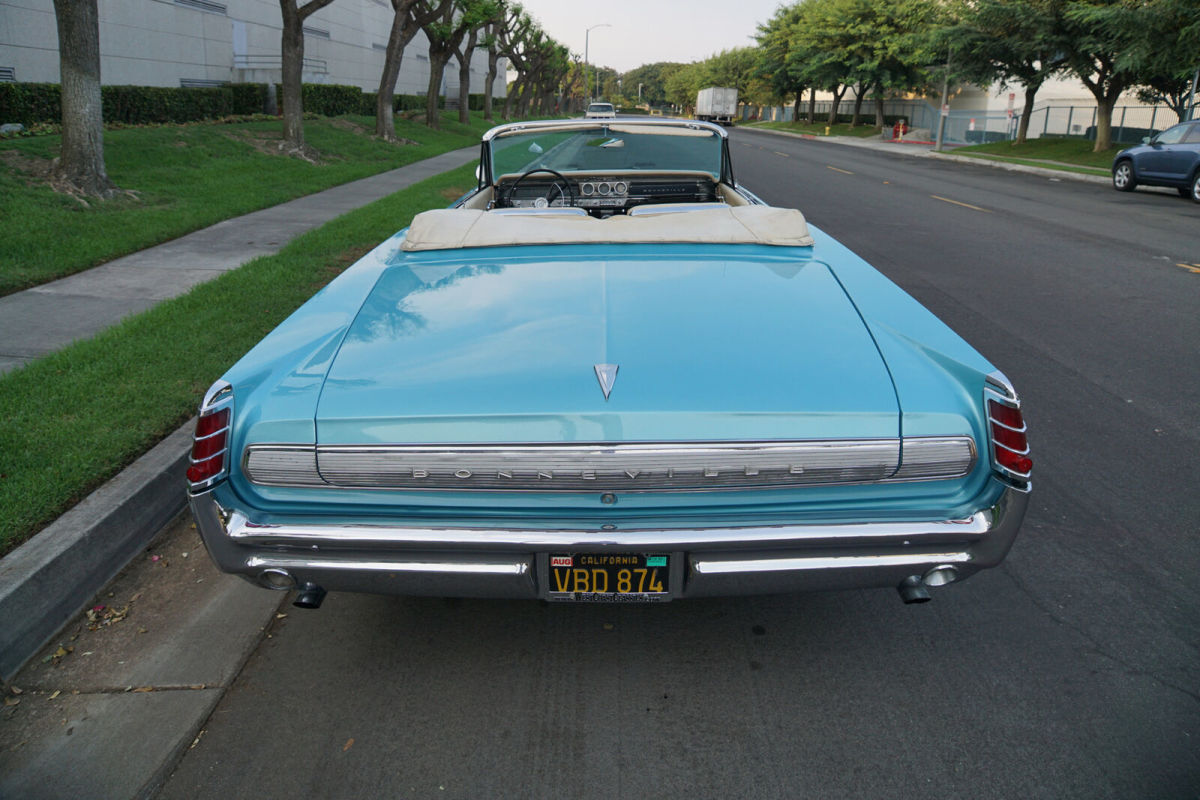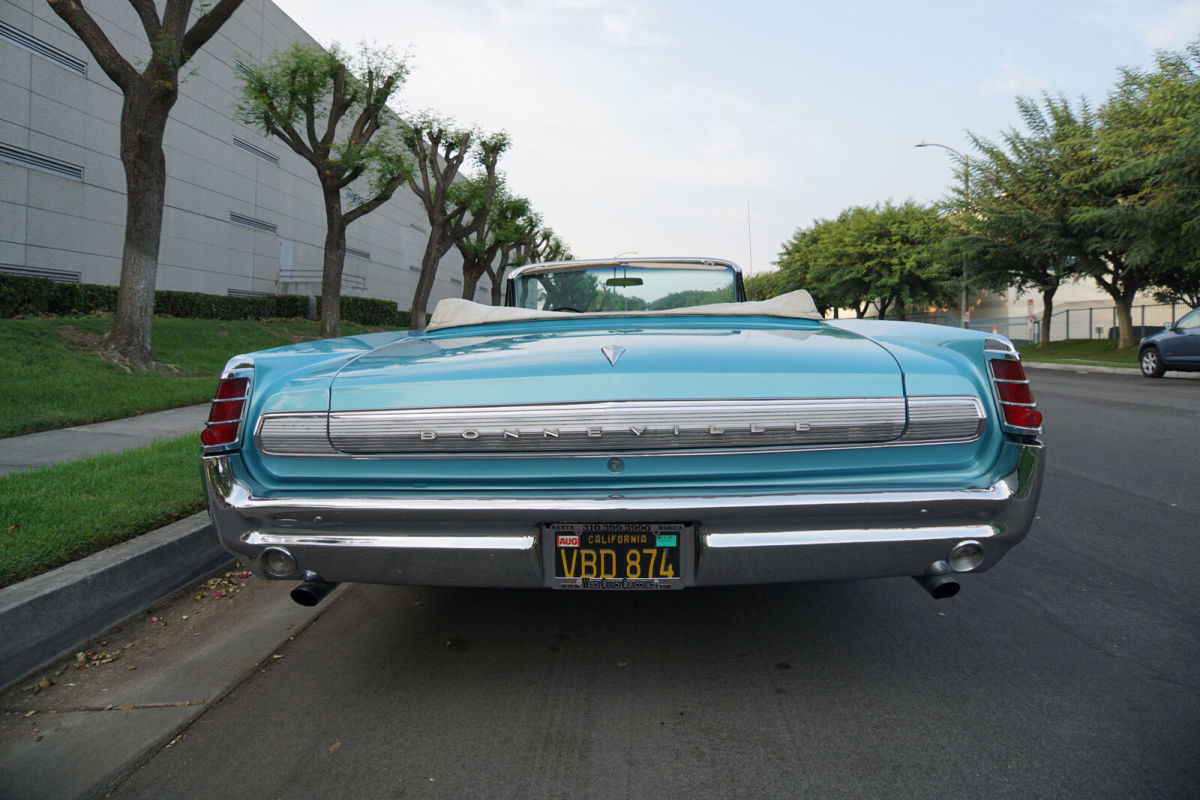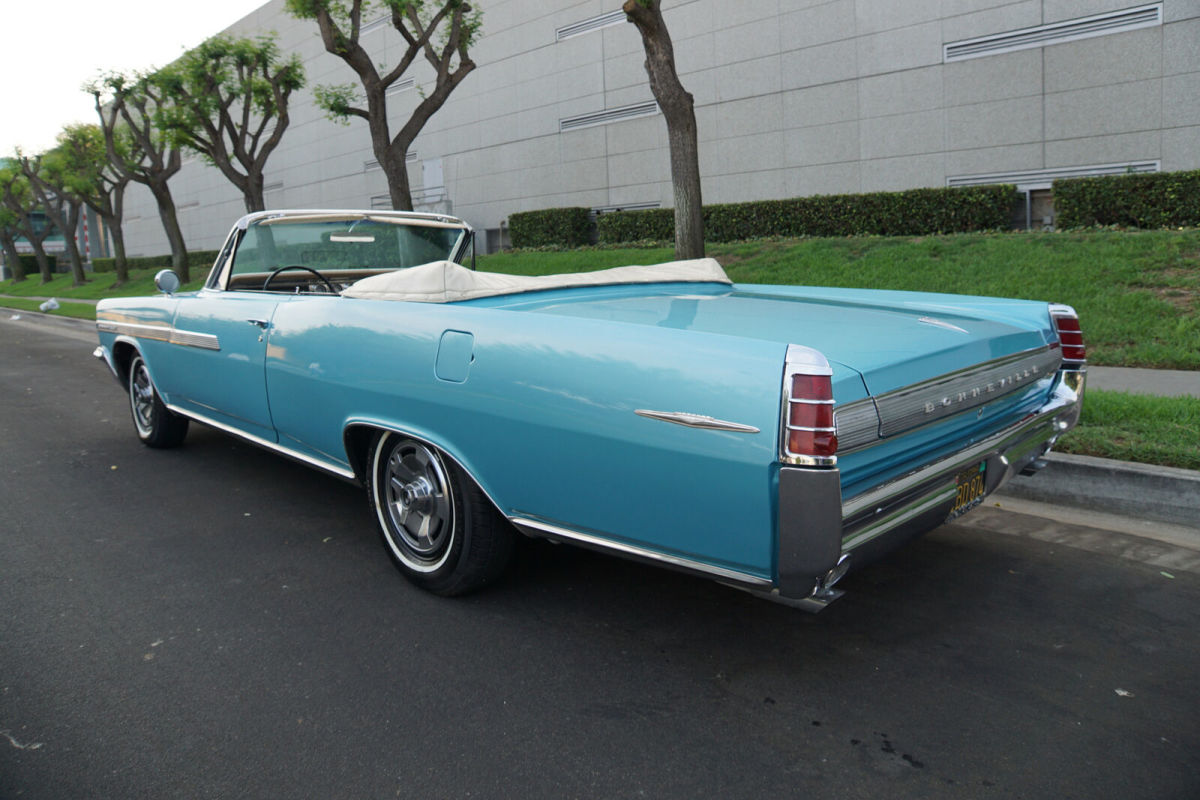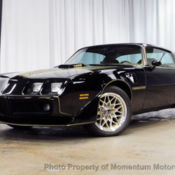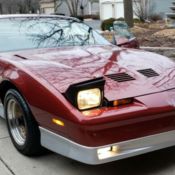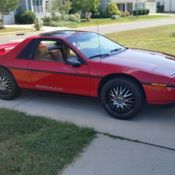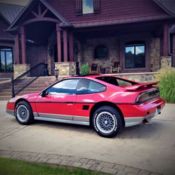0 Miles 389 V8 AutomaticConvertible
Technical specifications of Pontiac Bonneville 400 V8 Convertible 1963
| Price: | US $32,500.00 |
|---|---|
| Condition: | Used |
| Item location: | Torrance, California, United States |
| Make: | Pontiac |
| Model: | Bonneville 400 V8 Convertible |
| Type: | Convertible |
| Year: | 1963 |
| Mileage: | 0 |
| VIN: | 863P605597 |
| Color: | Blue |
| Engine size: | 389 V8 |
| Power options: | -- |
| Fuel: | Gasoline |
| Transmission: | Automatic |
| Drive type: | -- |
| Interior color: | White |
| Options: | -- |
| Vehicle Title: | -- |
| You are interested? | Contact the seller! |
Description
West Coast Classics are proud to present an exceptional example of this original California 'Black License Plate' 1963 Pontiac Bonneville 2 door V8 Convertible in original factory 'Marlin Aqua' (Code Q) color paint with a 'Fawn' color interior and seats and with a 'White' power convertible top and boasting a later model upgraded (1967 XX code) 400/325HP V8 engine with factory options including: Hydra-Matic automatic transmission, front bucket seats with center console, full carpeting including lower door panels, cushioned instrument panel, chrome exterior trim, power steering, power brakes, deluxe steering wheel, original Pontiac 'Super Deluxe' AM radio, heater, original and desirable factory Pontiac hubcaps with period correct tires & dual exhausts!Repainted once in it's original and highly striking factory 'Marlin Aqua' color paint & boasting an original bucket seats interior with center console and with the floor boards, trunk and all the typical rust-prone areas solid and rust-free and with the car having no indication of any accidents - obviously an always garaged and cherished California car since new!
The car looks very impressive with all it's original logos and its original 'Pontiac Super Deluxe' radio and power antenna and with the brightwork design on the dashboard, the dashboard itself, and the carpets and seats all in very presentable condition throughout. All the chrome work is also in very good condition and the original spare wheel is in the trunk. This particular car drives very well with the transmission shifting smoothly through all the gears and with the temperature always remaining cool!
It is hard to pin down the first actual muscle car; some have asserted that it is the 1949 Oldsmobile Rocket 88, which was built with speed in mind and with an overhead valve V8 placed in a mid-size car with a relatively lightweight body. A lot of observers cite the next big step in the evolution of the early muscle car to be the introduction of the 1955 Chrysler C-300 with its 300 horsepower Hemi engine that could go from zero to sixty in 9.8 seconds and reach a top speed of around 130 miles per hour. A car that came along a few years later that is of note to many collectors and muscle car enthusiasts is the Pontiac Ventura. The Ventura hardtop of 1961 cost the same as the 1960 model but weighed 180lbs less. The new and shorter wheelbase by 4 inches 1961 Pontiac with the lighter bodies and stronger engines made Pontiac drag racers hard to beat on the street or strip and Pontiac won 21 of 52 NASCAR Grand National stock-car races this year. The 1961 Pontiac Ventura 389 with the standard 389 cubic inch OHV V8 and three two-barrels was capable of going from a standing position to sixty miles per hour in a brief 8.2 seconds, and it could get a quarter mile in 15.5 seconds and reach 93 miles per hour in the process. They were offered with the famed bubble-top body style and the eye catching 'Jeweltone Morrokide' upholstery and were similar in design to the marque's top of the line model the legendary Pontiac Bonneville!
The Bonneville name was introduced in 1954 on a pair of bubble-topped GM Motorama concept cars called the Bonneville Special. It entered the production lineup as a high-performance, fuel-injected luxury convertible within the Star Chief line in the 1957 model year and was loaded with every conceivable option as standard equipment with the exception of optional air conditioning. This put the Bonneville in a Cadillac-like price range of $5,000 - more than double the base price of a Chieftain four-door sedan. A fully equipped Bonneville could cost more than a Cadillac. Only 630 units were produced that first year, making it one of the most collectible Pontiacs of all time today. The following year it would become its own separate model and it would endure until 2005 as the division's top-of-the-line model. The name was taken from the Bonneville Salt Flats in Utah, the site of much early auto racing and most of the world's land speed record runs, which was named in turn after U.S. Army officer Benjamin Bonneville. Bonneville became a separate model in 1958 and was available as a coupe or a convertible. It paced the Indianapolis 500 in its first year.
In its third year, the 1959 Bonneville became a full top-line series with the addition of the four-door hardtop sedan and Safari station wagon body styles. The Bonneville played an important part that year in the introduction of two of Pontiac's greatest marketing inspirations the split grille and the Wide Track slogan. The latter was not just ad copy, either, as Pontiac pushed its wheels further out toward the fenders than anyone else and created what were considered to be the best-cornering full-size cars in the industry. Both the grille design and the Wide Track phrase remained part of Pontiac's image up to its termination. A "Safe-T-Track" differential, used to minimize wheel spin, was an option beginning in 1959.The Bonneville remained as Pontiac's costliest and most luxurious model throughout the 1960s and was instrumental in pushing Pontiac to third place in sales from 1962 to 1970.
The Bonneville differed from its lesser Catalina and Star Chief counterparts by featuring more luxurious interior trim with upgraded cloth and Morrokide vinyl or expanded Morrokide upholstery in sedans and coupes, expanded Morrokide in Safari wagons or genuine leather seating in convertibles. Bonnevilles (with the exception of Bonneville Safari Station wagons) were also (along with Star Chiefs) built on a longer wheelbase version of GM's B-Body. Also found in the Bonneville were instrument panels and door panels with walnut veneer trim, carpeted lower door panels, grab bar on passenger side of dash and courtesy lights and rear arm rest. Beginning in 1964, a Bonneville Brougham option package was available that included an even more luxurious interior trim level with front and rear seats featuring center armrests, upgraded door panels and a standard Cordova (vinyl) roof with 'Brougham' nameplates.
Bonneville models were standard equipped with Hydra-Matic (through 1964) or Turbo Hydra-Matic (1965-on) automatic transmissions. Other options included power steering and power brakes as well as air conditioning. The Bonneville also had more powerful standard V8 engines than other full-sized Pontiacs including the 389 cu in (6.4 l) or 400 cu in (6.6 l) V8s with four-barrel carburetors with many optional V8 offerings available including Tri-Power (three two-barrel carburetor) options on both the 389 cu in (6.4 l) and 421 cu in (6.9 l) V8s that offered up to 376 hp (280 kW) through 1966. For 1962, Pontiac also offered the 421 cu in (6.9 l) Super Duty with two four-barrel carburetors, rated at 405 hp.
This is a great opportunity to own a wonderful daily driving example of a 1963 Pontiac Bonneville Convertible with a 400 V8 engine and one very rare and highly desirable and unabused example of one of the outstanding early rag top muscle cars from the early sixties.

